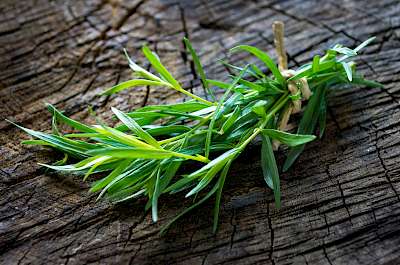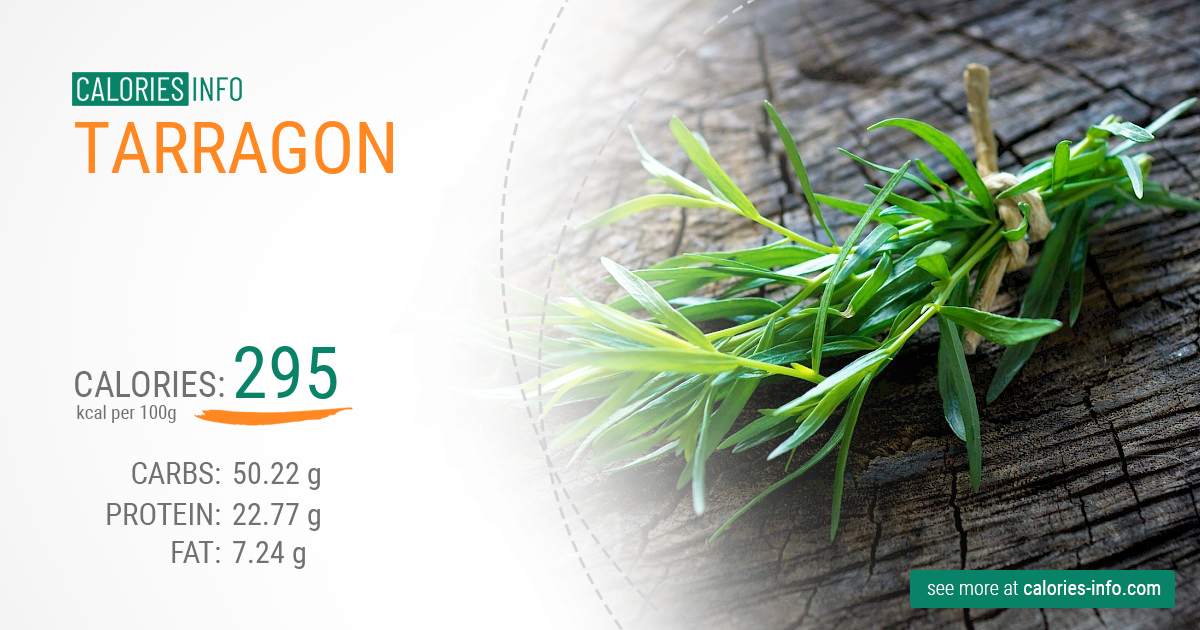Tarragon: Calories and Nutrition Analyse
How many calories in tarragon?

Nutrition Facts
TarragonServing size:
handful of tarragon (20 g) change
5g10g15g20g30g40g50g60g80g100g120g140g160g180g200g220g250g300g350g400g450g500g600g700g800g900g1000g
1oz2oz3oz4oz5oz6oz7oz8oz10oz12oz15oz20oz25oz30oz35oz40oz50oz
Amount Per Serving:
100g of tarragon contain about 295 calories (kcal).
Calories per:
ounce
| handful
| tablespoon
| bunch
| cup
| half cup
For example, a handful of tarragon (20 g) contain about 59 calories.
This is about 3% of the daily caloric intake for an average adult with medium weight and activity level (assuming a 2000 kcal daily intake).
Scroll down for details and nutrition tables.
To visualize how much 59 kcal actually is, keep in mind that the calorie content of handful of tarragon is similar to that of, for example:
- 1 apple
- 0.5 glass of Coca Cola (220 ml glass)
- 0.5 slice of cheese
- 0.5 slice of bread
- 3 cubes of sugar
Take a quick look at the tables below for detailed information about tarragon nutrition.
100g of Tarragon
Nutrition
- Calories295
- Carbs Total50.22 g
- Dietary fiber7.4 g
- Fat7.24 g
- Protein22.77 g
Vitamins
- Vit A4200 IU
- Vit B1 (Thiamine)0.251 mg
- Vit B2 (riboflavin)1.339 mg
- Vit B3 (Niacin)8.95 mg
- Vit B62.41 mg
- Vit B9 (Folic acid)274 mcg
- Vit C50 mg
Minerals
- Potassium3020 mg
- Magnessium347 mg
- Calcium1139 mg
- Sodium62 mg
- Iron32.3 mg
- Zink3.9 mg
Discover the Nutritional Powerhouse: Tarragon
Often hailed as a culinary herb for its distinctive flavor, Tarragon is not just a kitchen staple but also a nutritional powerhouse. This herb, with its bittersweet taste and an aroma reminiscent of anise, is more than just a flavor enhancer. Let's dive into the world of Tarragon and uncover the myriad of health benefits it offers, focusing on its nutritional profile, including Tarragon calories, protein in Tarragon, fat in Tarragon, and carbs in Tarragon.
Nutritional Snapshot of Tarragon
For those keeping an eye on their dietary intake, understanding the nutritional content of Tarragon is crucial. Here's a breakdown of what this herb packs in terms of nutrition per 100 grams:
- Calories: 295 - making it a low-calorie addition to any diet.
- Carbohydrates: 50.22g, with a dietary fiber content of 7.4g, aiding in digestion and satiety.
- Fat: 7.24g - predominantly healthy fats that are essential for body functions.
- Protein: 22.77g - a significant amount for a herb, contributing to muscle repair and growth.
- Vitamins and Minerals: Tarragon is rich in Calcium (1139mg), Iron (32.3mg), and Magnesium (347mg), alongside a notable amount of Potassium (3020mg) and Vitamins A (4200 IU) and C (50mg).
The Role of Tarragon in a Healthy Diet
Integrating Tarragon into your diet can offer numerous health benefits, thanks to its rich nutritional profile. Here's how the components of Tarragon contribute to a healthy lifestyle:
- Low Calories: With only 295 calories per 100 grams, Tarragon can be a flavorful addition to meals without adding excessive calories.
- Protein-Rich: The high protein content in Tarragon supports muscle health and recovery, making it an excellent herb for fitness enthusiasts.
- Healthy Fats: The fats in Tarragon are essential for brain health and maintaining healthy skin.
- Carbohydrates and Fiber: Its carbs provide energy, while the fiber content helps maintain a healthy digestive system.
- Vitamins and Minerals: Tarragon is a treasure trove of essential nutrients, supporting bone health, boosting the immune system, and aiding in red blood cell formation.
Whether you're looking to enhance the flavor of your dishes or boost your nutritional intake, Tarragon is an excellent herb to include in your diet. Its unique taste and health benefits make it a versatile ingredient that can be used in a variety of culinary creations. From salads and sauces to infused vinegars and teas, Tarragon adds a touch of elegance and a boost of nutrition to every dish.
In conclusion, Tarragon is not just a culinary delight but also a nutritional gem. Its low calorie content, combined with high levels of protein, healthy fats, and essential vitamins and minerals, make it an ideal addition to a balanced diet. So, the next time you're looking to add flavor and nutrition to your meals, consider reaching for Tarragon.
How many calories are there in 1, 2, 3, or 5 servings of tarragon leaves?
- Handful of tarragon leaves (20g)59 kcal
- Tablespoon of tarragon (3g)9 kcal
- Bunch of tarragon leaves (35g)103 kcal
- Cup of tarragon (31g)91 kcal
- Half cup of tarragon (15.5g)46 kcal
- Ounce (oz) of tarragon84 kcal
- Half of medium size servings of tarragon29.5 kcal
- Small size serving of tarragon (16g)47.2 kcal
- Big size tarragon (26g)76.7 kcal
- Two medium size servings of tarragon leaves118 kcal
- Three medium size servings of tarragon leaves177 kcal
- Four medium size servings of tarragon leaves236 kcal
- Five medium size servings of tarragon leaves295 kcal

Similar calories number have:
See also:
Read this:
- How many calories do blackcurrants have?
- Calories in a half of melon
- Calories in whole melon
- Calories for one, two or more melons
- Calories in slice of melon
- How many carbs (carbohydrates) in cherimoya?
- How much fat in cherries?
- How much protein in Cranberries?
- What is weight of date?
- Durian calories per ounce (oz)
- Black lilac calories per serving size


Add comment